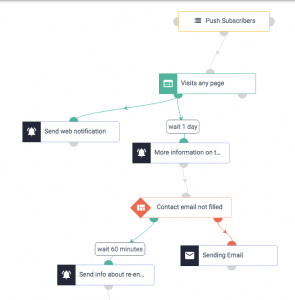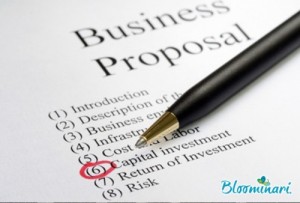Key features of a successful B2B eCommerce website including on-site search, purchase options, VAT toggle. real-time stock and live chat.
According to data from Forrester, up to 90% of the B2B customer journey is complete by the time prospects land on a company’s website because they’ve already researched the company and products before visiting.
The same report also finds that 93% of B2B buyers prefer to purchase online, which justifies the rise in B2B eCommerce as brands aim to break down online purchase barriers. In this article, we look at the key features of a B2B eCommerce website that maximise sales and keep customers coming back for more.
What is a B2B eCommerce website?
A B2B eCommerce website is an online store where businesses can go to buy the products they need to operate. This can range from office supplies and furniture to manufacturing parts and bulk product purchases.
The B2B aspect refers to any “business to business transaction” whilst the eCommerce element means customers can buy and pay for the product on the website.
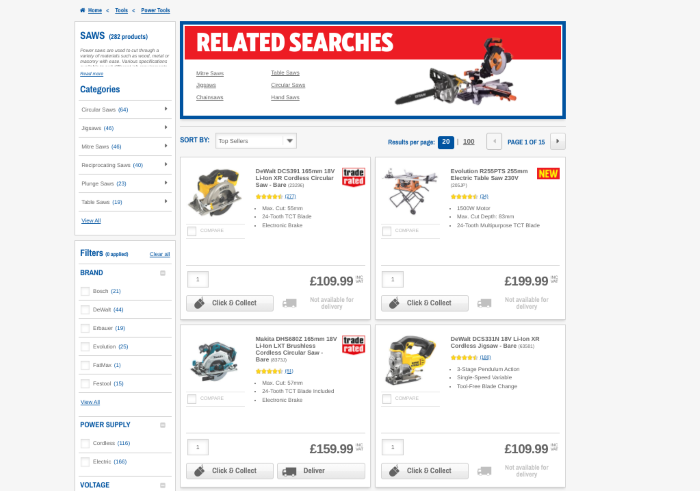 The Screwfix website is a true eCommerce platform in every sense
The Screwfix website is a true eCommerce platform in every sense
In practical terms, B2B websites can look and operate in a very similar way to their B2C counterparts. Users can browse products, add them to their shopping cart, choose their delivery method and pay for their order.
This is especially true for B2B brands selling wholesale goods to businesses who then sell them on individually to the end customer or companies like Screwfix who sell directly to tradespeople and small businesses.
For other B2B brands selling online, some of the traditional eCommerce features may be less desirable. For example, manufacturers and distributors don’t necessarily want product prices listed on their website, as they sell products at varying prices to different customers, depending on the size of their orders and purchase history.
In some cases, companies can be B2B and B2C and provide different eCommerce experiences for each type of customer.
Regardless of how many similarities there may be between B2B and B2C eCommerce websites, there are important differences that must be catered for in the design, development and optimisation processes.
What is the difference between B2B & B2C eCommerce?
The most important aspect of a B2B website is how it handles customer accounts. For B2B brands, everything revolves around customer accounts and this is the focal point of every design, development and marketing decision you make. For example, B2C eCommerce websites often allow customers to check out as guests but this isn’t much help to B2B companies.
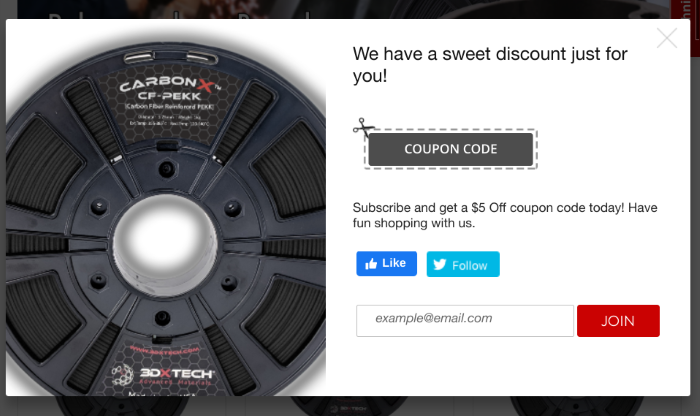 3DXTech entices visitors to create an account with a special offer “just for you”.
3DXTech entices visitors to create an account with a special offer “just for you”.
Every B2B transaction should be assigned to an account because, without this, you can’t provide some of the most important features of B2B purchases:
- Account-based pricing based on the purchase history and projected lifetime value of individual customers.
- Account-based discounts, promotions and offers tailored to the needs and interests of each customer.
- Account credit allowing customers to click and buy while settling their account at the end of the month with limits based on their purchase history.
- Repeat orders: Automatic repeat orders or a click-to-buy feature allowing for fast, frictionless repeat purchases.
- Order tracking providing customers with real-time info so they can plan accordingly.
- Product recommendations based on purchase history.
- Personalised marketing using purchase histories and online actions to deliver more relevant and compelling messages.
- Customer service: Through accounts, you can provide a higher quality of customer service and cater to the individual needs of each customer.
Accounts are crucial for maximising lifetime customer value with incentives to keep buying from you. A lot of this comes down to customised pricing but one of the most powerful avenues of B2B eCommerce is attributing user data to individual accounts: time spent on your website, pages visited, products compared, items added to baskets, purchases not completed and so much more.
By assigning this data to individual accounts, you can provide a highly-personalised experience that keeps customers engaged, maximises purchases and makes it difficult for them to shop anywhere else.
Key features of a B2B eCommerce site
As explained in the previous section, customer accounts define the B2B eCommerce experience and this should inform every design and development decision you make. It’s all about breaking down friction points standing in the way of sales, incentivising purchases and maximising lifetime customer value.
So let’s look at some of the key website features that will help you achieve this.
1. Customer registration
The first feature you need on any B2B eCommerce website is a customer account infrastructure, starting (on the user’s end) with an account registration system. Depending on the kind of products you sell, you might allow new customers to checkout on their first purchase by simply providing an email address, which allows you to start compiling basic data, but you want to get these users/customers signed up to an account as early as possible.
2. Filters & on-site search
If you have a large catalogue of products with a lot of variations (eg: size, brand, specification, etc,), then you need to provide an intuitive system of filters so that customers can quickly narrow in on the products they need. You should also provide advanced on-site search, including the same filter settings to find products without navigating through unnecessary pages.
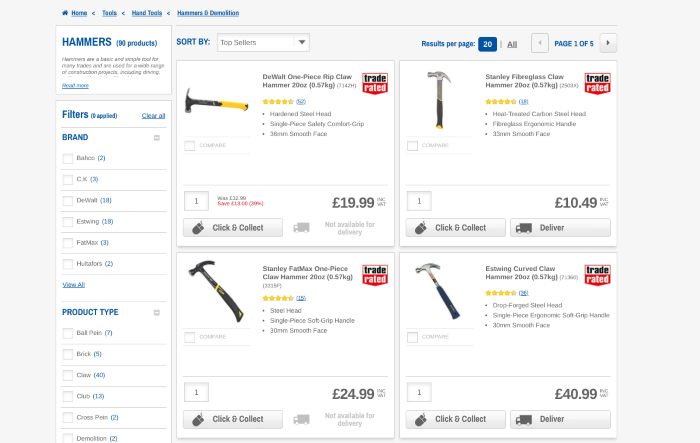
3. Complete product specifications
You need to provide a complete set of product specifications so that customers can make informed purchase decisions. Make sure this information is accessible and easy to find, especially information related to quality, safety, dimensions and any USPs that might help customers choose items with confidence.
4. High-quality product images
Buying online always comes with the added anxiety of not being able to see and touch the product with your own eyes. To help your customers buy the right products with confidence, provide high-quality, detailed images for every product that shows all of the visual information a buyer might need to see about the product in question.
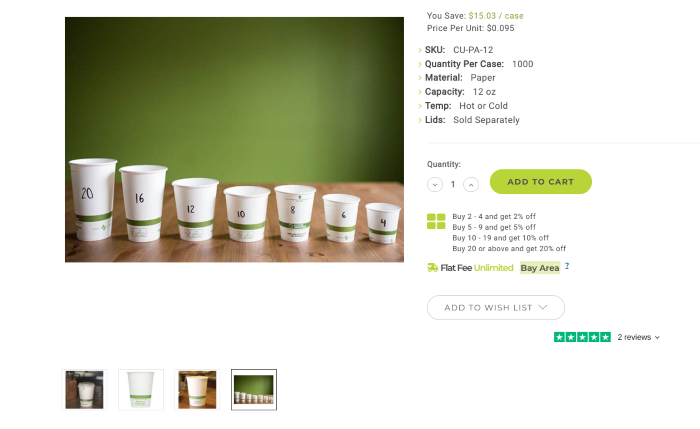 High-res product images here show the quality of the product and comparative size among the typical range of items
High-res product images here show the quality of the product and comparative size among the typical range of items
5. Purchase options
Make sure all of the purchase options available are clearly specified and easy to understand. For example, highlight any bulk purchase options and minimum order quantities that apply to products – don’t let users find out too late that they can’t buy the quantity they’re after.
Also, clearly display any discounts applied to bulk orders and encourage users to sign up for a customer account or log in to access custom prices or set up repeat orders.
It can be challenging to integrate multiple purchase options into a single page without overloading users with information and causing decision fatigue. So you’ll need to test variations to find the best combination that works and apply these findings across your website.
6. VAT toggle
Always provide pricing information including and excluding VAT and, better yet, include a toggle switch allowing users to choose which price they see first to make browsing and comparison easier – especially on product listing and results pages.
7. Real-time stock counts
Add a real-time stock counter to your pages so that customers can use this information for bulk purchases. The other benefit of this is that, as your stock counts get lower, scarcity will encourage businesses to buy sooner or in larger quantities rather than miss out – particularly for in-demand items.
8. Estimated delivery times & order tracking
Estimated delivery times help businesses buy with confidence and plan around their purchases. Fast delivery times can build trust with long-term customers while knowing they have to place orders by a certain time can also increase purchase intent.
We talked about order tracking earlier and this is another key feature for reassuring customers post-purchase and providing valuable information that helps them plan accordingly.
9. Payment options
Given the account-based nature of B2B eCommerce, you can offer a wider range of payment options that provide greater flexibility and remove purchase barriers. Of course, you’re going to want a secure payment portal with solid coverage of major card providers but you should also consider which account-based payment options you want to offer on a customer-to-customer basis.
You might include a click-to-buy feature for customers to purchase on credit – to a specified limit – and settle their account at the end of each month. This is standard in offline B2B transactions and it translates perfectly for digital channels by removing steps in the purchase process and allowing customers to complete repeat purchases with less friction.
10. Live chat support
Given that the majority of B2B traffic is ready to make the purchase when they land on your website, you want to do everything in your power to help them complete the job. Live chat support provides a channel for customers to get in touch if they experience any problems or can’t find the information they’re looking for.
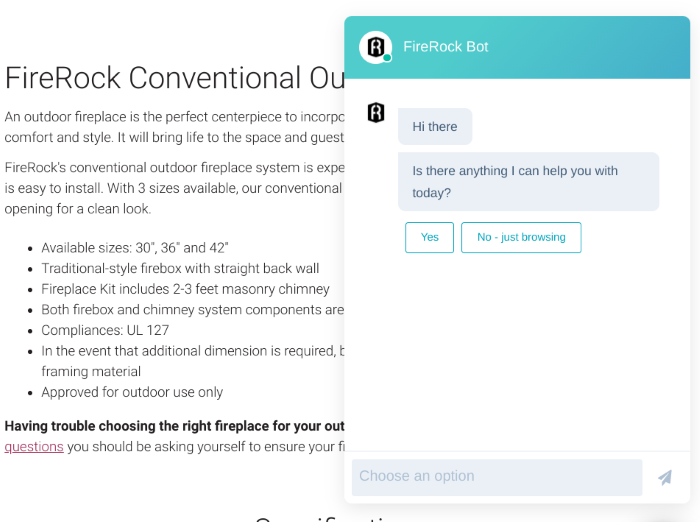 FireRock’s chatbot provides the first line of customer support on its website.
FireRock’s chatbot provides the first line of customer support on its website.
You don’t even need human beings to handle the first interaction, which can be carried out through a chatbot until customers reach a point where they need to engage with a person.
11. Security
The easier you make it for customers to spend money, the more robust your security needs to be. Security works on two fronts: perceived security and actual security – both of which are important. Perceived security is how confident customers feel their money is with you and this should naturally increase over time but you have to work a little harder to win those first few purchases. Everything from the design of your site, HTTPS encryption, T&Cs, payment options and financial guarantees help increase the perceived security of your site and reduce any purchase anxiety.
To maintain customers confidence, you need to back the perception up with genuine security measures that protect your customers’ money and data.
12. GDPR compliance
We’ve spent a lot of time in this article talking about the power of customer accounts and the data they help you to compile. So we have to spend some time talking about GDPR compliance and data privacy/security measures in general (GDPR isn’t the only legislation you need to adhere to).
In the case of GDPR, these regulations protect personal data of individual people so it’s not so relevant with data such as company names but very relevant to any data you collect and store of people at those companies – including any email addresses assigned to individuals.
GDPR also requires you to take certain data security measures that will apply to all of your data and, while this applies to personal data once again, it makes sense to be equally dedicated to protecting all of your customer data.
Putting it all together
B2B buyers are people too and they face all of the same online challenges as other consumers. This is why so many of the features that work for B2C online stores are found in the most successful B2B eCommerce sites, too – features like product searches, filters, checkouts, etc.
That said, B2B businesses and customers also have unique needs and it’s arguably even more important to satisfy these than the common grounds. B2B brands also have unique opportunities to capture account-based customers and double down on strategies like customer retention and maximising lifetime value.
Digital & Social Articles on Business 2 Community
(29)
Report Post
